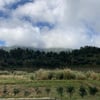Every post on my website now has an auto-generated og:image. I was curious if this could be done all from within the Netlify build phase. Here are my findings.
If you don't know what an og:image is, just have a look at the picture below. Open Graph images show up the moment you share a link to Facebook, LinkedIn, Twitter, WhatsApp, etc. As you can see, I chose to compile the image from the post title, website URL and a personal photo.
There is some prior art on auto-generating og:image, for example Open Graph Image as a Service by Zeit. They've built an API endpoint that generates the image on every request. I didn't want to have a separate API function because it feels like a waste of resources if the images don't change after deploy anyway. It turns out to work wonderfully in Netlify's build step!
The steps involved in generating the images are:
- Initiating the script during Gatsby's
onPostBuild - Booting up puppeteer (Chrome)
- Rendering an HTML template
- Updating the H1 element with the post title
- Making a screenshot and saving it to
/public - Repeating steps 4 and 5 for all posts.
- Configuring the Open Graph / Twitter meta tags
Initiating the script during Gatsby's onPostBuild
The Gatsby onPostBuild API only runs when building for production and not during development. For this reason we will be using it, since we don't need og:image during development, and generating them slows down compilation.
Here is an example of how I take all the posts from the Gatsby data layer and send them to the function that generates the images. The query might look different for your use case, since I use .mdx files as a data source, with frontmatter for metadata.
// gatsby-node.js
import generateOgImages from './src/scripts/generate-og-images';
exports.onPostBuild = async ({ graphql }) => {
const result = await graphql(`
query {
posts: allMdx {
nodes {
fields {
slug
}
frontmatter {
title
}
}
}
}
`);
await generateOgImages(result.data.posts.nodes);
};
Booting up puppeteer (Chrome)
We'll render HTML in puppeteer and screenshot it, in order to get our image. Puppeteer is a bit too heavy for the Netlify build step and won't work. We'll work around this by using a package called chrome-aws-lambda that is made to work within the limitations of a AWS Lambda function.
npm i chrome-aws-lambda puppeteer-core
npm i -D puppeteer
By accessing puppeteer through the chrome-aws-lambda instance, we'll automatically get the right chromium for our context (local development vs. Netlify).
// generate-og-images/index.js
const chromium = require('chrome-aws-lambda');
module.exports = async posts => {
const browser = await chromium.puppeteer.launch({
args: chromium.args,
executablePath: await chromium.executablePath,
headless: chromium.headless,
});
const page = await browser.newPage();
// Here we'll add the screenshot logic
await browser.close();
};
Ok, I'm kidding, it does not work outside of the box. The Netlify build step runs with NODE_ENV=development, which confuses chrome-aws-lambda. We could work around this by setting the NODE_ENV to production, but this has unintended side effects. Another way to force using the serverless chrome instance is by setting the AWS_LAMBDA_FUNCTION_NAME environment variable (docs).
Netlify does let us set this environment variable through their UI, so we'll just hack it into our netlify config.
# netlify.toml
[build]
command = "AWS_LAMBDA_FUNCTION_NAME=trickpuppeteer npm run build"
Screenshotting HTML templates
In the same folder as the script, we'll create an HTML template file.
<!-- generate-og-images/template.html -->
<html>
<head>
<meta charset="utf-8" />
<style>
/*SEE THE REPOSITORY FOR ALL THE STYLES*/
</style>
</head>
<body>
<section>
<img src="./avatar.jpeg" />
<h1 id="title">
Lorem ipsum dolor sit amet
</h1>
<p>Gersom.nl</p>
</section>
</body>
</html>
Then we'll load this HTML file into our script and inject it into puppeteer to make screenshots.
// generate-og-images/index.js
const chromium = require('chrome-aws-lambda');
const fs = require('fs');
const path = require('path');
module.exports = async posts => {
const browser = await chromium.puppeteer.launch({
args: chromium.args,
executablePath: await chromium.executablePath,
headless: chromium.headless,
});
const page = await browser.newPage();
// Load html from template
const html = fs
.readFileSync(path.resolve(__dirname, './template.html'))
.toString();
// Render html
await page.setContent(html, {
waitUntil: ['domcontentloaded'],
});
// Wait until the document is fully rendered
await page.evaluateHandle('document.fonts.ready');
// Set the viewport to your preferred og:image size
await page.setViewport({
width: 1200,
height: 632,
// My macbook is retina, so this should be 2 while testing locally
deviceScaleFactor: process.env.NETLIFY === 'true' ? 1 : 2,
});
// Create an og-images directory in the public folder
const dir = path.resolve(__dirname, '../../../public/og-images');
if (!fs.existsSync(dir)) fs.mkdirSync(dir);
// Go over all the posts
for (const post of posts) {
// Update the H1 element with the post title
await page.evaluate($post => {
const element = document.querySelector('#title');
element.innerHTML = $post.frontmatter.title;
}, post);
// Save a screenshot to public/og-images/slug-of-post.jpeg
await page.screenshot({
path: `${dir}/${post.fields.slug.replace(/\//g, '')}.jpeg`,
type: 'jpeg',
quality: 100,
clip: { x: 0, y: 0, width: 1200, height: 632 },
});
}
await browser.close();
};
This should run without error, but if you try this yourself, you'll find that the relative paths to the avatar (and font-face declarations in CSS) won't resolve in puppeteer. I ended up base64-injecting them:
// generate-og-images/index.js
let html = fs
.readFileSync(path.resolve(__dirname, './template.html'))
.toString();
let avatar = fs.readFileSync(path.resolve(__dirname, './avatar.jpeg'), {
encoding: 'base64',
});
html = html.replace(
'./avatar.jpeg',
`data:image/jpeg;charset=utf-8;base64,${avatar}`
);
let font = fs.readFileSync(path.resolve(__dirname, './Roboto-Bold.ttf'), {
encoding: 'base64',
});
html = html.replace(
"'./Roboto-Bold.ttf'",
`data:application/x-font-ttf;charset=utf-8;base64,${font}`
);
Configuring the Open Graph / Twitter meta tags
Lastly, we organize our meta tags, so Twitter, WhatsApp and others know where to find our image.
import Helmet from 'react-helmet';
// DEPLOY_URL is a Netlify environment variable.
// You can set this to localhost in a .env.development file, for dev testing.
const image = `${process.env.DEPLOY_URL}/og-images/${slug}.jpeg`;
<Helmet>
<meta property="og:image" content={image} />
<meta name="twitter:image" content={image} />
</Helmet>;
That's it, thanks for reading! Let me know here or on Twitter if this worked for you.








Top comments (0)